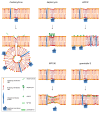The Diverse Activities and Mechanisms of the Acylphloroglucinol Antibiotic Rhodomyrtone: Antibacterial Activity and Beyond
- PMID: 39452203
- PMCID: PMC11504083
- DOI: 10.3390/antibiotics13100936
The Diverse Activities and Mechanisms of the Acylphloroglucinol Antibiotic Rhodomyrtone: Antibacterial Activity and Beyond
Abstract
Background/Objectives: The rose myrtle Rhodomyrtus tomentosa is a medicinal plant used in traditional Asian medicine. The active compound in R. tomentosa leaf extracts is rhodomyrtone, a chiral acylphloroglucinol. Rhodomyrtone exhibits an impressive breadth of activities, including antibacterial, antiviral, antiplasmodial, immunomodulatory, and anticancer properties. Its antibacterial properties have been extensively studied. Methods: We performed a comprehensive literature review on rhodomyrtone and summarized the current knowledge about this promising acylphloroglucinol antibiotic and its diverse functions in this review. Results: Rhodomyrtone shows nano to micromolar activities against a broad range of Gram-positive pathogens, including multidrug-resistant clinical isolates, and possesses a unique mechanism of action. It increases membrane fluidity and creates hyperfluid domains that attract membrane proteins prior to forming large membrane vesicles, effectively acting as a membrane protein trap. This mechanism affects a multitude of cellular processes, including cell division and cell wall synthesis. Additionally, rhodomyrtone reduces the expression of inflammatory cytokines, such as TNF-α, IL-17A, IL1β, and IL8. Generally showing low toxicity against mammalian cells, rhodomyrtone does inhibit the proliferation of cancer cell lines, such as epidermal carcinoma cells. The primary mechanism behind this activity appears to be the downregulation of adhesion kinases and growth factors. Furthermore, rhodomyrtone has shown antioxidant activity and displays cognitive effects, such as decreasing depressive symptoms in mice. Conclusions: Rhodomyrtone shows great promise as therapeutic agent, mostly for antibacterial but also for diverse other applications. Yet, bottlenecks such as resistance development and a better understanding of mammalian cell toxictiy demand careful assessment.
Keywords: Rhodomyrtus tomentosa; acylphloroglucinol; antimicrobial activity; mode of action; natural product; plant-derived antimicrobials; rhodomyrtone.
Conflict of interest statement
The authors declare no conflicts of interest. The funders had no role in the design of the study; in the collection, analyses, or interpretation of data; in the writing of the manuscript; or in the decision to publish the results.
Figures







Similar articles
-
Rhodomyrtone-rich fractions from Rhodomyrtus tomentosa (Aiton) Hassk. leaves: A potent antimicrobial compound for Staphylococcus pseudintermedius.Vet World. 2025 Apr;18(4):1025-1035. doi: 10.14202/vetworld.2025.1025-1035. Epub 2025 Apr 30. Vet World. 2025. PMID: 40453951 Free PMC article.
-
The novel antibiotic rhodomyrtone traps membrane proteins in vesicles with increased fluidity.PLoS Pathog. 2018 Feb 16;14(2):e1006876. doi: 10.1371/journal.ppat.1006876. eCollection 2018 Feb. PLoS Pathog. 2018. PMID: 29451901 Free PMC article.
-
Immunomodulatory effects of Rhodomyrtus tomentosa leaf extract and its derivative compound, rhodomyrtone, on head kidney macrophages of rainbow trout (Oncorhynchus mykiss).Fish Physiol Biochem. 2018 Apr;44(2):543-555. doi: 10.1007/s10695-017-0452-2. Epub 2017 Dec 13. Fish Physiol Biochem. 2018. PMID: 29238889
-
Rhodomyrtus tomentosa (Aiton.): A review of phytochemistry, pharmacology and industrial applications research progress.Food Chem. 2020 Mar 30;309:125715. doi: 10.1016/j.foodchem.2019.125715. Epub 2019 Oct 21. Food Chem. 2020. PMID: 31685368 Review.
-
Antimicrobial Capacity of Plant Polyphenols against Gram-positive Bacteria: A Comprehensive Review.Curr Med Chem. 2020;27(15):2576-2606. doi: 10.2174/0929867325666181008115650. Curr Med Chem. 2020. PMID: 30295182 Review.
References
-
- Arip M., Selvaraja M., Rajagopal M., Tan L.F., Leong M.Y., Tan P.L., Yap V.L., Chinnapan S., Tat N.C., Abdullah M., et al. Review on Plant-Based Management in Combating Antimicrobial Resistance—Mechanistic Perspective. Front. Pharmacol. 2022;13:879495. doi: 10.3389/fphar.2022.879495. - DOI - PMC - PubMed
-
- World Health Organization . The Selection and Use of Essential Medicines 2023: Executive Summary of the Report of the 24th WHO Expert Committee on the Selection and Use of Essential Medic. World Health Organization; Geneva, Switzerland: 2023. Web Annex A: World Health Organization Model List of Essential Medicines—23rd List, 2023.
-
- World Health Organization . WHO Bacterial Priority Pathogens List, 2024: Bacterial Pathogens of Public Health Importance to Guide Research, Development and Strategies to Prevent and Control Antimicrobial Resistance. World Health Organization; Geneva, Switzerland: 2024.
-
- World Health Organization . WHO Fungal Priority Pathogens List to Guide Research, Development and Public Health Action. World Health Organization; Geneva, Switzerland: 2022.
Publication types
Grants and funding
LinkOut - more resources
Full Text Sources
Molecular Biology Databases
Research Materials

